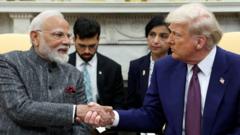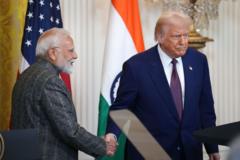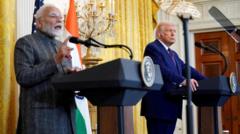President Trump’s new tariffs on countries trading with Russia, if implemented, stand to reshape global markets and impact energy prices. Despite the intended consequences, experts warn this may result in higher prices for U.S. consumers and disrupt trade relationships, particularly with India and China.
Trump’s Proposed Tariffs on Russia May Send Shockwaves Through Global Markets

Trump’s Proposed Tariffs on Russia May Send Shockwaves Through Global Markets
President Trump’s announcement of secondary tariffs against any nation trading with Russia aims to pressure Moscow amidst the ongoing war in Ukraine, but could significantly impact global trade dynamics and energy prices.
In an attempt to weaken Russia's financial stronghold amid its ongoing war in Ukraine, President Trump has declared sweeping secondary tariffs targeting nations that engage in trade with Russia. These tariffs would impose a staggering 100% tax on imported goods from any country that continues to facilitate trade with Moscow unless a ceasefire in Ukraine is reached by August 8.
Despite being heavily sanctioned, Russia has leveraged its energy wealth to sustain its military actions. Trump aims to pivot this trend by penalizing countries like China, India, and Turkey, who remain primary customers of Russian oil and gas, as he noted, “I used trade for a lot of things, but it's great for settling wars.” These new tariffs, reminiscent of previous sanctions imposed during his administration, could usher in sweeping changes to the global economy if they indeed materialize.
Analysts from consultancy firms like Capital Economics have weighed in on the potential impact of secondary tariffs on energy prices. If enacted, they could significantly restrict Russian oil and gas exports to international markets, driving prices higher reminiscent of the inflation spike observed after Russia's full-scale invasion of Ukraine in 2022. Trump's confidence in U.S. oil production counters concerns raised by experts about the overall energy market's stability. However, they point out that OPEC+ may possess enough spare capacity to mitigate immediate price shocks.
Russia has developed sophisticated means to evade sanctions, such as its "shadow fleet" of tankers to obscure oil origins. This raises questions about the effectiveness of new tariffs. India, now the second-largest buyer of Russian oil, characterized the targeting of its trade as "unjustified." Should these tariffs come into existence, U.S. consumers may face doubling costs for certain products like iPhones, as import taxes increase and are likely passed onto consumers.
The scale of trade between the U.S. and India is relatively minor compared to that with China, where secondary tariffs could become a contentious issue. With U.S. imports from China exploding fivefold those from India, imposing tariffs could complicate ongoing trade negotiations and risk exacerbating the inflation crisis in the U.S.
Attention has turned towards the interdependencies created by energy reliance, as despite efforts to limit Russian imports, European countries still rely on its resources. Secondary sanctions could intensify pressures on the EU, particularly as many member states face the consequences of maintaining trades with Russia while navigating new tariffs on U.S. exports.
The ripple effects of Trump's proposed tariffs could stretch even further. Russian officials have signaled that they may be on the verge of a recession, further heightening the stakes as the conflict remains unresolved. Trump hopes to leverage these economic measures to lessen Russia’s footing in the war against Ukraine, potentially altering the current global economic landscape in the process.


















